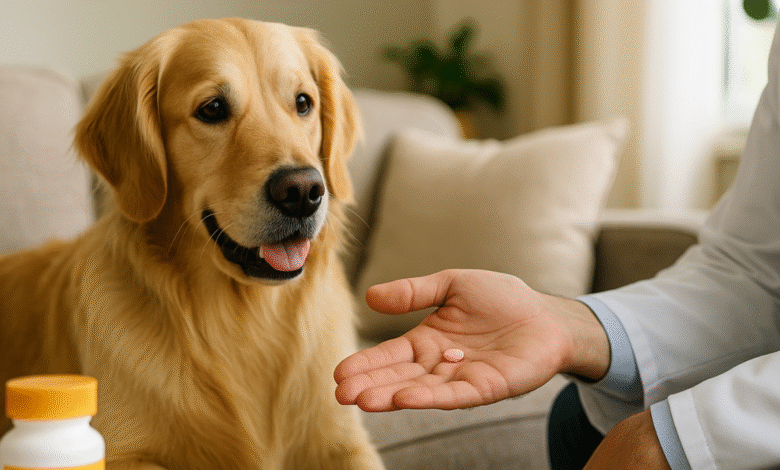Benadryl for Dogs: The Complete Expert Guide Every Dog Owner Should Read

Learn everything about Benadryl for dogs, including safety, dosage, side effects, and expert tips. A complete, easy-to-understand guide for pet parents who want the best care for their dogs.
Introduction to Benadryl for Dogs
As a loving pet parent, you’ve probably experienced that moment of panic when your dog suddenly starts itching, sneezing, or breaking out in hives. Naturally, your first thought is how to bring them relief quickly. One of the most common over-the-counter medications people think of is Benadryl. But the big question is: is Benadryl safe for dogs?
The short answer is yes, in most cases, Benadryl can be safe for dogs, but that doesn’t mean it’s a one-size-fits-all solution. Understanding the uses, proper dosage, risks, and limitations is essential before you reach for that familiar pink box. Giving your dog medication is not the same as giving it to a human; their bodies react differently, and even small mistakes can have big consequences.
In this guide, we’ll take a deep dive into everything you need to know about Benadryl for dogs. From allergy relief to travel anxiety, we’ll break down what’s safe, what’s risky, and what every responsible pet owner should keep in mind. By the end, you’ll feel confident about whether Benadryl is the right choice for your furry friend.
What Exactly is Benadryl?
Benadryl is the brand name for the drug diphenhydramine, a first-generation antihistamine. It’s been around for decades and is commonly used in humans to relieve symptoms of allergies, hay fever, colds, and even insomnia. It works by blocking histamine, a chemical released during allergic reactions that causes itching, swelling, and runny noses.
For dogs, Benadryl can also help with mild allergic reactions, insect bites, and skin irritations. In some cases, veterinarians may even recommend it for motion sickness or mild anxiety. However, the fact that it works for some dogs doesn’t automatically mean it’s safe for all dogs. Just like humans, dogs have individual health needs, underlying conditions, and varying sensitivities to medication.
It’s worth noting that not all formulations of Benadryl are safe for dogs. Some versions contain additional active ingredients such as decongestants or pain relievers that can be toxic. That’s why it’s important to know not just if you can give Benadryl, but also which kind and how much.
Why Do People Use Benadryl for Dogs?
Benadryl has earned a reputation among dog owners as a kind of “go-to” home remedy, and for good reason. It’s accessible, relatively inexpensive, and can sometimes provide quick relief. Still, the reasons why pet owners turn to Benadryl vary, and it’s important to understand each situation separately.
For many, the most common reason is allergy relief. Dogs can suffer from environmental allergies just like humans—think pollen, dust, mold, or even household cleaning products. The itching, scratching, watery eyes, and constant licking can be tough to watch, and Benadryl often brings relief in mild cases.
Another big reason is bug bites and stings. Whether it’s a mosquito bite during a summer walk or a bee sting in the backyard, these can trigger localized allergic reactions in dogs. Benadryl may help reduce swelling and discomfort, though severe reactions always require immediate veterinary attention.
Some owners also use Benadryl for travel anxiety or motion sickness. While it’s not as effective as medications specifically designed for anxiety, Benadryl’s drowsy side effect can sometimes help nervous dogs relax on long car rides. However, this should only be done under veterinary guidance since sedation can mask other problems.
How Benadryl Works in Dogs
When a dog ingests Benadryl, the diphenhydramine goes into the bloodstream and blocks histamine receptors in the body. Histamine is the culprit behind swelling, itching, and redness during allergic reactions. By limiting histamine’s activity, Benadryl reduces those symptoms and helps your dog feel more comfortable.
In addition, Benadryl has mild sedative effects because it can cross the blood-brain barrier and affect certain brain chemicals. This is why some dogs become drowsy after taking it, making it occasionally useful for calming mild anxiety or restlessness.
However, the sedative effect can be unpredictable. Some dogs may barely feel it, while others may become too drowsy. A small percentage may even have the opposite reaction, becoming hyperactive or restless instead of calm. That’s why observing your dog closely after giving them Benadryl is so important.
Situations Where Benadryl May Help
To give you a clearer picture, here are some specific situations where Benadryl may be helpful for dogs:
| Situation | How Benadryl Helps | When to Seek Veterinary Help |
|---|---|---|
| Seasonal Allergies | Reduces itching, watery eyes, and sneezing | If symptoms persist for weeks or worsen |
| Insect Bites or Bee Stings | Lowers swelling and irritation | If your dog has trouble breathing or face swelling |
| Mild Food Allergies | Eases mild itching or hives | If vomiting, diarrhea, or severe swelling occurs |
| Motion Sickness | May reduce nausea and drowsiness can calm the dog | If repeated vomiting or refusal to travel |
| Anxiety | Sedation may take the edge off | For chronic or severe anxiety, use vet-prescribed meds |
This table is not a substitute for veterinary advice but gives an overview of common situations where Benadryl may be appropriate.
When Benadryl is NOT Safe for Dogs
While Benadryl can be beneficial in many cases, there are also clear situations where it should be avoided. Knowing when not to use it is just as important as knowing when to use it.
For starters, dogs with certain health conditions should not take Benadryl without veterinary approval. This includes dogs with glaucoma, heart disease, high blood pressure, thyroid problems, or urinary tract issues. In these cases, Benadryl could worsen their condition or interact with medications they’re already taking.
Pregnant or nursing dogs should also avoid Benadryl unless specifically cleared by a vet. Puppies under twelve weeks old may be too sensitive for it as well. And finally, if your dog is already on sedatives, antihistamines, or antidepressants, adding Benadryl could cause dangerous interactions.
Another important factor is emergencies. If your dog is having a severe allergic reaction—such as swelling of the face, difficulty breathing, or collapse—Benadryl is not enough. These situations require immediate veterinary care, often involving stronger medications and sometimes even hospitalization.
Correct Dosage of Benadryl for Dogs
One of the most common questions pet owners ask is: how much Benadryl can I give my dog? The general rule of thumb recommended by many veterinarians is 1 milligram of Benadryl per pound of body weight, given two to three times daily.
For example, a 25-pound dog would typically get 25 milligrams of Benadryl every eight to twelve hours. However, this is only a guideline. Some dogs may need a slightly lower or higher dose depending on their health, age, and sensitivity.
| Dog’s Weight | Typical Benadryl Dose |
|---|---|
| 10 lbs | 10 mg |
| 25 lbs | 25 mg |
| 50 lbs | 50 mg |
| 75 lbs | 75 mg |
| 100 lbs | 100 mg |
It’s crucial to always check the label of the product you’re using. Some Benadryl formulations come in liquid or chewable forms, and concentrations may vary. Using children’s liquid Benadryl can be tricky since it may contain sweeteners like xylitol, which is toxic to dogs. Always avoid formulations with extra ingredients.
Side Effects of Benadryl in Dogs
Like any medication, Benadryl comes with the possibility of side effects. The most common is drowsiness, which some owners may actually find useful in cases of anxiety or travel. However, excessive drowsiness can make your dog lethargic and less responsive.
Other side effects may include dry mouth, urinary retention, or gastrointestinal upset such as vomiting and diarrhea. Rarely, dogs may have paradoxical reactions, becoming hyperactive instead of sleepy.
Severe side effects, though uncommon, include rapid heartbeat, difficulty breathing, or seizures. If you notice these signs, stop the medication immediately and contact your veterinarian.
Natural Alternatives to Benadryl for Dogs
Not every pet owner is comfortable giving over-the-counter human medication to their dogs, and that’s perfectly understandable. Thankfully, there are natural alternatives that may help with mild allergies or anxiety.
For allergies, omega-3 fatty acid supplements can reduce inflammation and support skin health. Regular baths with hypoallergenic shampoos can also remove allergens from the skin and coat. Quercetin, sometimes referred to as “nature’s Benadryl,” is a plant-based supplement with anti-inflammatory properties that may help allergic dogs.
For anxiety, natural calming products like chamomile, CBD oil (from pet-safe sources), and pheromone diffusers can be helpful. Training and behavioral therapy also play a huge role in long-term anxiety management.
Expert Quotes on Benadryl for Dogs
“Benadryl can be a useful tool for mild allergic reactions in dogs, but it’s not a cure-all. The best approach is always tailored to the individual pet.” – Dr. Sarah Collins, DVM
“I tell pet parents that if their dog has trouble breathing, no amount of Benadryl at home will help. That’s an emergency situation for the vet.” – Dr. Michael Lane, Emergency Vet Specialist
Frequently Asked Questions (FAQs)
Q: Can I give my dog Benadryl every day?
A: In some cases, veterinarians may approve daily Benadryl for chronic allergies. However, long-term use should always be monitored to avoid side effects and ensure it’s still effective.
Q: Can Benadryl be used for dog anxiety?
A: It may help mildly anxious dogs due to its sedative effect, but it’s not a reliable anxiety medication. For persistent anxiety, prescription options are more effective.
Q: How long does Benadryl take to work in dogs?
A: Most dogs start to feel the effects within thirty minutes, and it typically lasts between six to eight hours.
Q: What form of Benadryl is safest for dogs?
A: The plain, original version of Benadryl (diphenhydramine) is safest. Avoid products with added decongestants, alcohol, or xylitol.
Q: What should I do if my dog overdoses on Benadryl?
A: Signs of overdose include extreme lethargy, tremors, rapid heartbeat, or seizures. If you suspect an overdose, seek veterinary help immediately.
Conclusion
Benadryl for dogs can be a safe and effective option for treating mild allergies, bug bites, and occasional motion sickness. However, it’s not without risks, and it’s certainly not the solution for every problem. Knowing when it’s safe, what dosage to use, and when to seek veterinary help is the key to using it responsibly.
At the end of the day, while Benadryl is helpful in certain situations, your veterinarian is the ultimate authority. When in doubt, always call your vet before giving any medication. After all, our dogs depend on us to make the best choices for their health and well-being.





